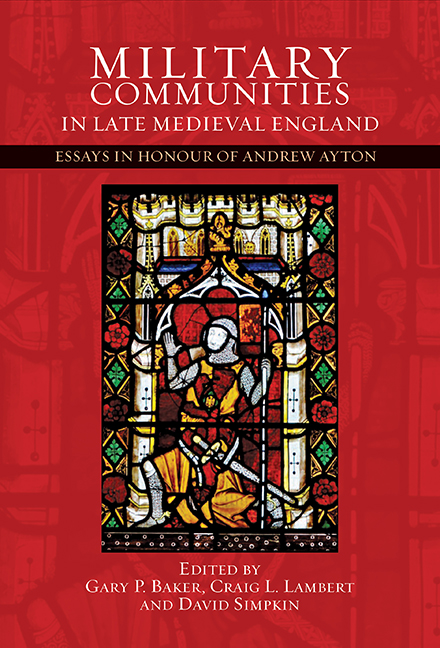Book contents
- Frontmatter
- Miscellaneous Frontmatter
- Contents
- List of Illustrations
- Acknowledgements
- List of Contributors
- Foreword
- Andrew Ayton: A Brief Tribute
- Andrew Ayton: A Recognition of his Work
- Abbreviations
- Part Title
- 1 ‘Big and Beautiful’. Destriers in Edward I's Armies
- 2 Cum Equis Discoopertis: The ‘Irish’ Hobelar in the English Armies of the Fourteenth Century
- 3 Andrew Ayton, the Military Community and the Evolution of the Gentry in Fourteenth-Century England
- 4 Knights Banneret, Military Recruitment and Social Status, c. 1270–c. 1420: A View from the Reign of Edward I
- 5 Sir Henry de Beaumont and His Retainers: The Dynamics of a Lord's Military Retinues and Affinity in Early Fourteenth-Century England
- 6 Financing the Dynamics of Recruitment: King, Earls and Government in Edwardian England, 1330–60
- 7 The Symbolic Meaning of Edward III's Garter Badge
- 8 Sir Robert Knolles’ Expedition to France in 1370: New Perspectives
- 9 The Organisation and Financing of English Expeditions to the Baltic during the Later Middle Ages
- 10 Naval Service and the Cinque Ports, 1322–1453
- 11 The Garrison Establishment in Lancastrian Normandy in 1436 according to Surviving Lists in Bibliothèque Nationale de France manuscrit français 25773
- Bibliography of the Writings of Andrew Ayton
- Index
- Tabula Gratulatoria
- Warfare in History
1 - ‘Big and Beautiful’. Destriers in Edward I's Armies
from Part Title
Published online by Cambridge University Press: 17 July 2019
- Frontmatter
- Miscellaneous Frontmatter
- Contents
- List of Illustrations
- Acknowledgements
- List of Contributors
- Foreword
- Andrew Ayton: A Brief Tribute
- Andrew Ayton: A Recognition of his Work
- Abbreviations
- Part Title
- 1 ‘Big and Beautiful’. Destriers in Edward I's Armies
- 2 Cum Equis Discoopertis: The ‘Irish’ Hobelar in the English Armies of the Fourteenth Century
- 3 Andrew Ayton, the Military Community and the Evolution of the Gentry in Fourteenth-Century England
- 4 Knights Banneret, Military Recruitment and Social Status, c. 1270–c. 1420: A View from the Reign of Edward I
- 5 Sir Henry de Beaumont and His Retainers: The Dynamics of a Lord's Military Retinues and Affinity in Early Fourteenth-Century England
- 6 Financing the Dynamics of Recruitment: King, Earls and Government in Edwardian England, 1330–60
- 7 The Symbolic Meaning of Edward III's Garter Badge
- 8 Sir Robert Knolles’ Expedition to France in 1370: New Perspectives
- 9 The Organisation and Financing of English Expeditions to the Baltic during the Later Middle Ages
- 10 Naval Service and the Cinque Ports, 1322–1453
- 11 The Garrison Establishment in Lancastrian Normandy in 1436 according to Surviving Lists in Bibliothèque Nationale de France manuscrit français 25773
- Bibliography of the Writings of Andrew Ayton
- Index
- Tabula Gratulatoria
- Warfare in History
Summary
What was a destrier? The word probably refers to the tradition that a squire led a charger with his right hand, though it is also possible that it related to the horse leading with the right leg as it charged. This does little to provide an answer. Relatively few horses were classed as destriers, as Andrew Ayton wisely pointed out: ‘There is a danger in assuming that all late medieval warhorses were destriers … which is like assuming every saloon car to be a Rolls-Royce.’ The lists of horses on the Falkirk campaign of 1298 include just thirty-eight destriers, out of a total of some 1,370. Destriers were elite mounts but, for the historian, they are not as easy to identify as Rolls- Royces are. It is far from clear what differentiated them from other horses. Size is the most likely explanation, but the evidence for their stature and weight is not consistent.
The traditional assumption was that destriers were very large. In 1900 J. E. Morris described them as ‘slow but powerful shire-horses’; more recently, R. H. C. Davis suggested, without citing any evidence, that they were seventeen or eighteen hands tall. That is equivalent to a modern Clydesdale. Andrew Ayton's carefully qualified view was that ‘the most expensive horses were, indeed, of formidable stature’. As recently as 2008, it was argued in a general history of cavalry that ‘the destrier was twice as large as a riding horse’. Recent work, using both pictorial and archaeological evidence, has suggested that this is implausible. As a result, the popular vision of knights trundling about on heavy draught horses, some so tall that their riders had to be mounted by means of cranes, has been replaced by a scholarly view that they rode small, nimble but sturdy horses, resembling Welsh cobs.
One argument is that pictorial evidence, such as the Bayeux Tapestry, the illustration of Sir Geoffrey Luttrell, mounted and armoured, or Ucello's fresco in Florence depicting Sir John Hawkwood, implies a height of no more than fifteen hands for a warhorse. Equally, while archaeological evidence is limited, there is nothing to support the hypothesis of the tall destrier. Material, primarily from London, such as horseshoes and bits, suggests that ‘the great majority of medieval horses did not reach the sort of fifteen-hands height and proportionate bulk that is today expected of an ordinary riding horse’.
- Type
- Chapter
- Information
- Military Communities in Late Medieval EnglandEssays in Honour of Andrew Ayton, pp. 1 - 14Publisher: Boydell & BrewerPrint publication year: 2018



